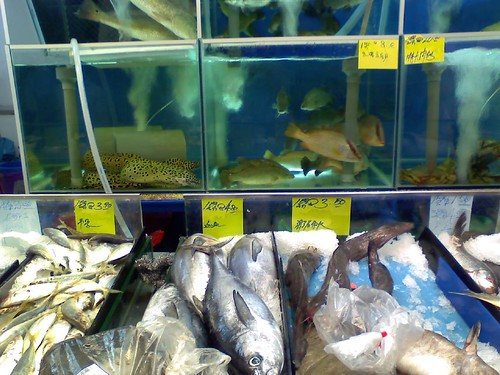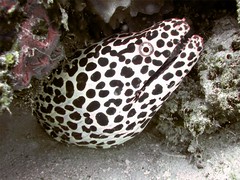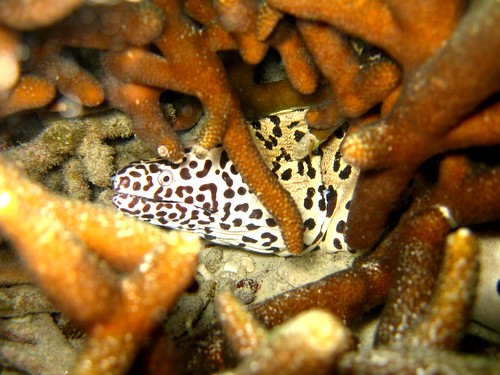![P26-03-09_19.14[01]](http://farm4.static.flickr.com/3622/3406456091_7148a47d4e.jpg)
Is there anyone with some proficiency in identifying moray eels? I've got a few low-quality photos of moray eels in a fish tank that need identification. I've been looking through FishBase, but haven't been able to find a picture of a moray eel with a colour pattern that is a perfect match for the species in my photos.

The moray eels were actually being offered for sale at the Bedok North outlet of Sheng Siong Supermarket. Yes, after writing about this post that was submitted to STOMP, I was curious enough to go and see if Sheng Siong was indeed selling moray eels for consumption.
Apologies for the lousy picture quality and resolution, but I only had my handphone camera with me at that time.
Does anybody want to try to help in determining the species of moray eel being sold? My hunch is that these are juveniles belonging to a species of Gymnothorax, but like I said, this is just a hunch.
So far, the most similar species I've managed to find are the honeycomb moray (Gymnothorax favagineus) and black-spotted moray (Gymnothorax isingteena).


Left: Honeycomb moray, Lombok;
(Photo by linda.sonia)
Right: Black-spotted moray, Maldives;
(Photo by le congre)
But as you can see from the examples above and elsewhere on the Internet, these two species are covered in small black spots, not the larger rosettes seen on the eels at Sheng Siong. Of course, we cannot rule out the possibility that the juveniles might have a different colour pattern from the adults.
I did manage to find this photo, which bears a much closer resemblance to the ones in my photos:

"IMG_3685_Black-spotted moray (Gymnothorax melanospilus)", Pulau Dayang;
(Photo by Tiomanese)
Gymnothorax melanospilus is an outdated name used for both the honeycomb moray and black-spotted moray, which does strengthen my suspicion that the moray eels being sold at Sheng Siong could belong to either one or even both of these species. But just to make sure, I hope someone with greater expertise can confirm my suspicions, or even purchase a specimen for closer study.
According to FishBase, the honeycomb moray has a very high vulnerability to overfishing, while the black-spotted moray has been assessed to have high to very high vulnerability. Given that it is likely that the moray eels at Sheng Siong were wild-caught, and are juveniles to boot, one worries about the sustainability of the moray eel fishery that is the source of these eels.
Being apex predators, moray eels have small population sizes and tend to breed slowly. While fears are growing about overexploitation of other apex predators of the reef such as sharks, groupers and humphead wrasse, moray eels have not been receiving much attention.
As far as I know, there is no significant market for moray eel flesh in Singapore, although if this post over at Fishingnewsroom.com is to be believed, moray eels are consumed in Hong Kong. This next video shows moray eels being slaughtered at a Taiwanese restaurant:
So there is a commercial market for moray eels in the region after all.
I guess there's nothing wrong with eating moray eels; right now, my interest is more to do with whether there is any need to import and sell live moray eels for food here in Singapore. Just how much demand is there for moray eels? How many moray eels does Sheng Siong import and sell every week? Where do these moray eels come from? Which demographic purchases and consumes moray eels? There are so many questions left unanswered.
On the flipside, I wouldn't be surprised if the moray eels are being bought by opportunistic aquarists. One man's meat may be another man's pet...